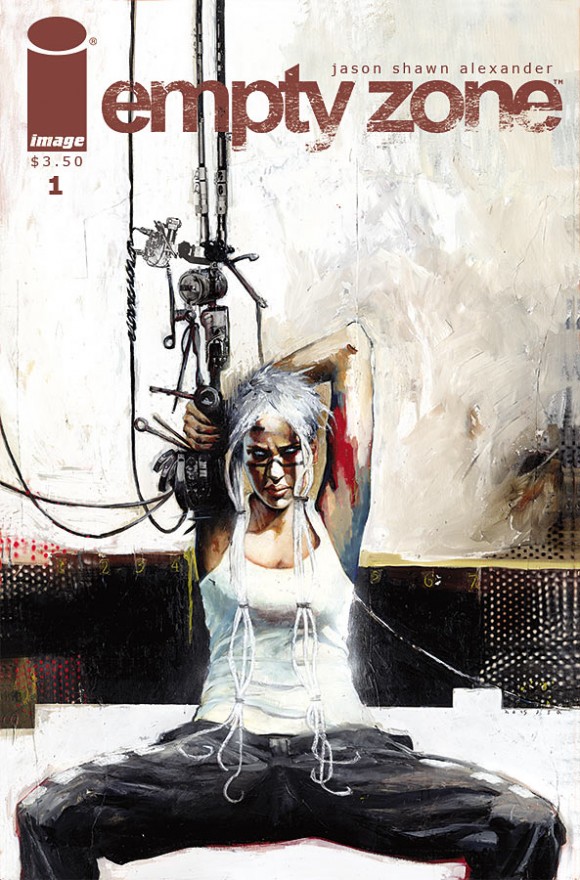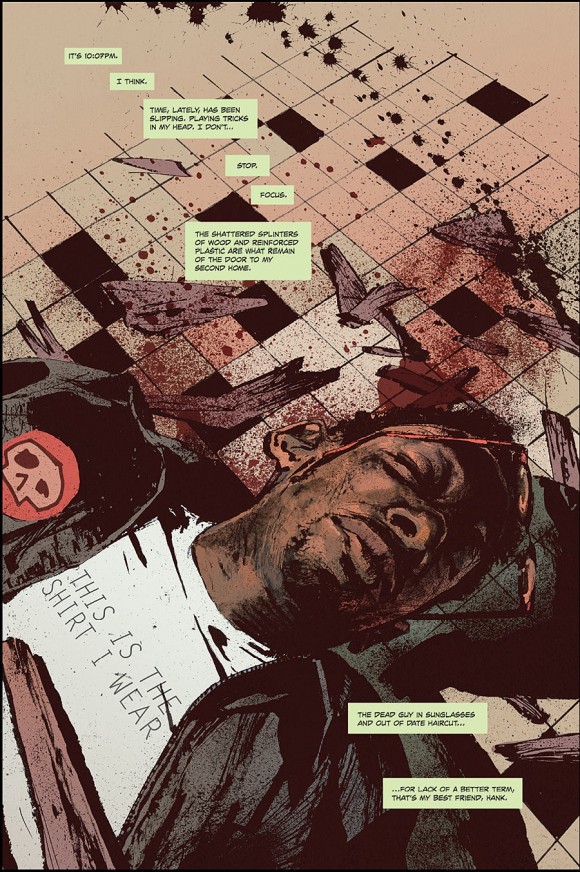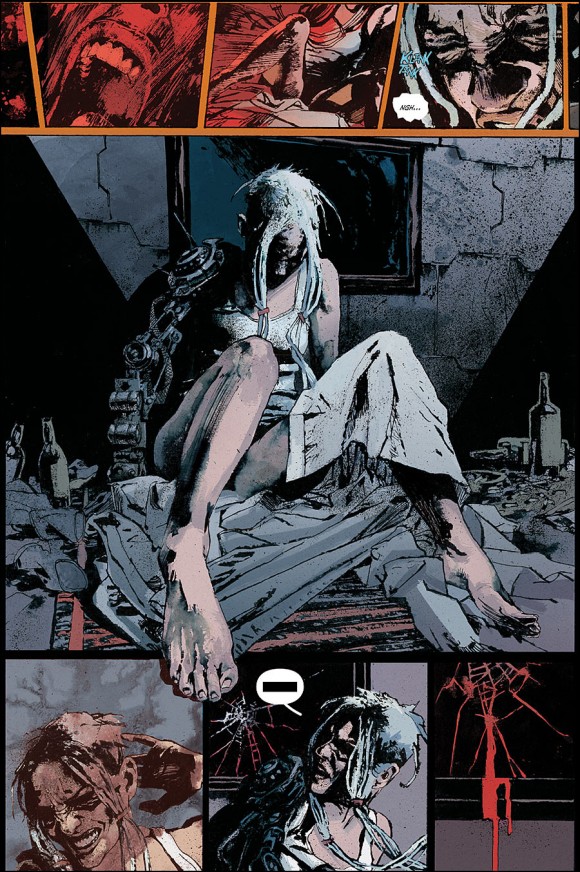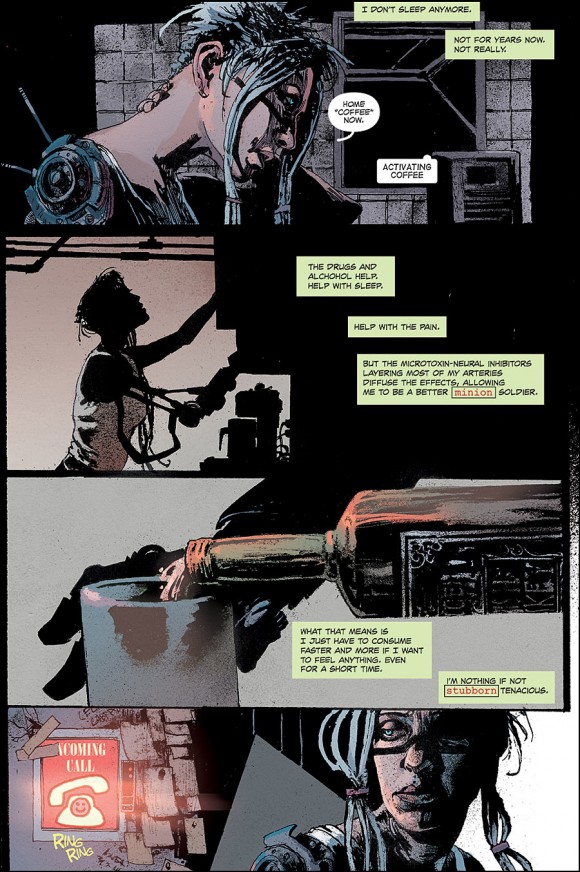Jason Shawn Alexander took time this week to answer our questions about his upcoming series Empty Zone from Image Comics.
__
Almost two decades ago, Jason Shawn Alexander created Empty Zone, which ended up being his first paid gig in comics. Since then, Alexander has carved out a nice career for himself, working both in comics and as a gallery artist, but, this Wednesday, after an extended hiatus, Alexander is returning to Empty Zone, which is being published by Image Comics. I’ve had a chance to read the first issue and I could tell you about how much I enjoyed reading this dystopic, sci-fi cyberpunk drama with supernatural and horror elements, and about the focus on a compelling female lead in a character-driven drama, and about how the art which has a great, frenetic feel borrowing from Alexander’s fine art work. I could do all of that, but I’d rather let Alexander tell you about it himself, so . . . .
G.D. Kennedy: Just to start, can you give our readers a quick overview what Empty Zone is about?
Jason Shawn Alexander: Empty Zone is a story about a lost soul finding purpose again. Ex-government spy, Corinne White, has little desire to live. She’s existing and working in the underground of 2140 Pittsburgh. Once a billionaire with political ties begins experimenting with the reanimation of corpses, Corinne’s world gets turned upside down. The series quickly goes from dystopian cyberpunk to a tale of the supernatural and horrific.
Empty Zone is a series that you started working on in the 1990s, and then left alone for a long while. Can you give us a bit of the background of the original series, and what brought you back to the series now? Is there a particular aspect of the story or characters that captured your attention?
Empty Zone was one of a few stories I created for an anthology series I co-published called Section8. It was noticed by a company called Sirius Entertainment. They gave me my first paying work in comics, doing Empty Zone. At that time, I simply wanted to do a series that combined elements of books like, Sin City, The Crow, and Neuromancer. As I began work on the second mini-series for Sirius, the story began to evolve and become something more personal, more mature. I began caring more for Corinne: I wanted to really explore what it would be like to have lost everything but to be given a special reason to go on.
Once I began the third mini-series, this time with a solid idea of where the series should go, I had a falling out with the publisher. After that I got work on Queen and Country through Oni Press and continued getting work through Dark Horse. Then, last year, my wife discovered the unpublished pages of the third Empty Zone series and flipped out. Once I explained what the story was she pushed me to get the rights back and continue it.
I had been working on a few scripts for graphic novels because I was feeling pretty burnt out with work-for-hire, and I started missing creator owned work. Empty Zone was the most fully realized, though, and I really wanted to bring back those old friends.
I have always found that looking back at long-past writing or artwork can be fascinating but also jarring, given intervening changes in perspective and experiences. What was it like for you delving back into these characters and concepts that you worked on when you were so much younger? How have these elements changed for you over time?
First and foremost is the art. When I first began Empty Zone I worked out of my head and my influences and experience were limited. Once I moved to North Carolina I met George Pratt and Kent Williams. They showed me how they worked from models. I shared a studio with Kent for a few years, learning how to grow and mature in my work. Working on these characters again, it does feel like I’ve gone through a time machine, but in a good way. I grew up through Empty Zone, artistically. The concept was good and now it’s even better. I now have the opportunity to tell the story in a more complete way.
Empty Zone was originally funded through a Kickstarter campaign. Why did you turn to Kickstarter for this series? What was the Kickstarter experience like for you? How was the series ultimately picked up by Image?
Kickstarter is effective and an amazing resource. But holy shit is it ever a type of work I never want to do again. At least not on my own. I have a wife and a new baby, so stopping work-for-hire to do a creator owned book is a financially scary prospect. Kickstarter sounded like a way to cover production costs and keep the lights on until (hopefully) the series became successful. Joe Keatinge, whom I worked with on a small Superman story, introduced me through email to Eric Stephenson at Image. I’ve had 20 years of working in comics and Empty Zone in my pocket, so Image agreed to give it a go.
Your lead, Corrine, is the same character from the 1990s series, and, if the first issue is any indication, the series is going to be very character-driven, substantially exploring her history and demons. What is it about Corrine that you find so compelling that you would come back to her? Is the present-day Corrine different than the incarnation from the 1990s?
The current incarnation of Corinne is a more mature one. She’s always been my outlet for a hard boiled, dark character in a distopian world. I created this character in the late 90’s that was dark, strong, and sexy (like most female characters in comics at that time), but deeply flawed. I’ve always been drawn to her for the latter.
She was one of the first comic characters I ever created: I think when you create a character, especially when you’re younger, you give that character a lot of yourself. She was one of my first outlets that I could put a great deal of myself into. Her being a woman allowed a certain level of mystery to me, as well. If a comic book character could be one of your closest friends, that would be Corinne. I’m excited for this relaunch because it allows me to approach the character and the world again, with more experienced eyes. Corinne is a more developed character now. Someone we will see, over time, evolve and change.
One of the things that caught my attention in the first issue was that while the book is overtly cyberpunk, it incorporates supernatural elements. These are, in many ways, binary elements rarely seen together, but they create a compelling basis to explore the concepts technology and humanity. What is it that led you to bring in supernatural elements? Is this dichotomy a theme that you intend to play with throughout the series?
Yes. The series becomes a supernatural/horror series set in a cyberpunk world. I love juxtaposing opposites. Stories like this tend to focus on elements of the time or environment. I like the idea that supernatural elements can be timeless, limitless. One of my favorite movies of all time is Jacob’s Ladder. That story could be told in any time, year, setting. We see ghost stories in present day and period pieces, but rarely in a futuristic sci-fi setting. I wanted to tell a very human story…and a ghostly one, but in an environment that it visually exciting.
A classic cyberpunk theme is the post-modern concept of layered realities and disassociation, and there are hints of this in the first issue works, with Corrine’s struggle to differentiate dream and waking, her general ambivalence to her day-to-day life, and the blurring of boundaries between technical and biological. This also reflects nicely on the supernatural elements of the story. How do you see this theme playing into the series?
There will be a constant push and pull of reality, dreams, and the supernatural in Empty Zone. I don’t believe I have to stick with a singular theme for a series. This is everything I want to write and draw, all poured into one title.
Over the past few years, you’ve focused largely on your gallery work, instead of comics. Why did you decide to shift back to comics now? Do you intend to incorporate more of your gallery-style work into Empty Zone as the series goes on?
I’ve told my gallery director, my life would be much easier if I could stick with one thing. But I’m addicted to storytelling and sequential art. Reading Will Eisner at the right time introduced me to what the comics medium was truly capable of. It’s close to a perfect visual and literary medium. If I was going to come back to more work in comics, I wanted the same freedom I’d grown accustomed to in my fine art; so I needed to do my own story.
As the series progresses, and I get more comfortable, there will definitely be more of my fine art approach in the work. Books like Stray Toasters paved a road for that kind of thing years ago. I don’t see a lot of that in comics today. I’m excited to experiment and push the medium as far as I can.
Your gallery paintings don’t require scripting or narrative in the same sense as a comic. How have you found the return to scripting? Have you been writing over the past few years, or is this something that you are returning to now with Empty Zone?
It’s true. Though my fine art tends to have narrative qualities, it allows me to be as vague and nondescript as I want. You can put a million different meanings in one painting. Each panel in a comic is like a film still. It has a purpose. It sets a mood, pulls us along. It’s a different discipline altogether. I’ve been scripting a few potential graphic novels on and off for the past 10 years. With Empty Zone, I wanted to re-introduce myself as a creator with something that had a bit of an existing fan base, but also, there has been this need to finish what I started. And, again, I’m addicted to story-telling.
A lot of artists have shifted to making art digitally, but, as I understand it, you still make art traditionally, which I think adds a great visceral quality to your work, but is somewhat ironic given that Empty Zone is replete with characters who have enhanced their natural selves with technology. Can you talk a bit about your artistic process and the reasons for sticking to traditional media?
We joke about that a lot. A number of my peers have gone to digital. I wouldn’t even know what to do with it. I still use a roller-ball with my computer. I even hate track pads. I love making art. Wether it’s paintings, drawings, or comic book pages. I want to feel the materials. Get my hands in it. Make mistakes and discover new things by trying to fix them. I want the history in the work to be present when you see it. I want to hold up a page and be able to touch it; see the smudges, the white out, the scratches. My goal has never been to just “make the image”.
Even though I work in illustration I’m not an efficient illustrator by any means. I shoot models for reference. I draw from that reference. I still collage and glue things to my pages. And there are fans and collectors out there that still enjoy seeing and owning pieces of art that are a part of a story they love. And nothing beats ink. I’m glad some guys can mimic what looks like ink, but nothing will ever beat the risk you take by laying down real line on real paper. That risk keeps everything interesting for me.
I think it’s pretty clear that William Gibson’s Neuromancer was a strong influence onEmpty Zone. Are there any other works that you are drawing on for this series? Do you have any suggested reading?
Of course it is! That story is brilliant. Snow Crash, by Stephenson is as well. But I get influenced by other sources too: Blood Meridian by Cormac McCarthy has been a big influence on me, as well as Chuck Palahnuik. Also, soundtracks, delta blues music, movies like Dark City and Jacob’s Ladder, Iron Giant, Rope… Everything that gets me going tends to find it’s way into my work.
Ultimately, what are your expectations for Empty Zone as it moves forward? Do you expect the series to be ongoing?
The series will be done in ongoing story arcs. I’d like to do one a year with an anthology or small mini-series – with other creators – in between. Empty Zone has so much room to grow, I don’t see it stopping anytime soon. I have the next 2 mini-series plotted out and once Corinne gets to Germany, things will get even more insane. This has so many elements I love to draw, watch, read…. It’s the most fun you can have doing a dark, violent series.




